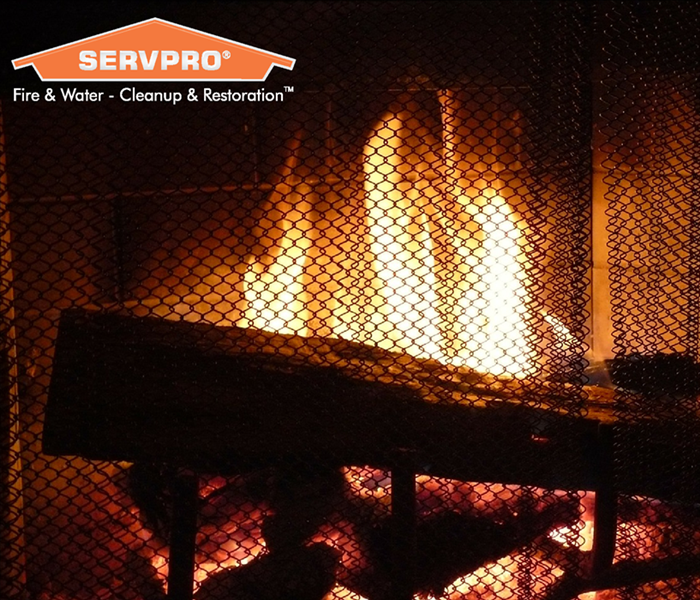Archived Fire Damage Blog Posts
How to Choose the Right Fire Restoration Company for Your Needs
5/1/2024 (Permalink)
Experiencing a fire in your home or business can be devastating, but choosing the right fire restoration company to help you rebuild and recover can make all the difference. With so many restoration companies out there, it's important to know what to look for to ensure you're partnering with a trusted and reliable service provider. In this blog post, we'll discuss some essential factors to consider when selecting a fire restoration company for your needs.
1. Expertise and Experience: Look for a fire restoration company with extensive experience and expertise in handling fire damage restoration projects. A company with a proven track record and a team of trained professionals will be better equipped to assess the damage, develop a comprehensive restoration plan, and execute the necessary repairs with precision and efficiency.
2. Licensing and Certification: Ensure that the fire restoration company you choose is properly licensed and certified to perform restoration work in your area. Look for certifications from reputable organizations such as the Institute of Inspection, Cleaning, and Restoration Certification (IICRC), which demonstrate the company's commitment to industry standards and best practices.
3. Prompt Response: Time is of the essence when it comes to fire damage restoration, so choose a company that offers prompt and reliable emergency response services. Look for a company that provides 24/7 availability and can dispatch a team to your location quickly to assess the damage and begin the restoration process without delay.
4. Comprehensive Services: Choose a fire restoration company that offers a wide range of services to address all aspects of fire damage restoration, including smoke and soot removal, odor elimination, structural repairs, and content cleaning and restoration. A company that can handle every aspect of the restoration process in-house will streamline the process and ensure a more seamless and efficient experience for you.
5. Transparent Pricing and Communication: Look for a fire restoration company that is upfront and transparent about their pricing and communicates openly with you throughout the restoration process. Avoid companies that provide vague estimates or try to upsell unnecessary services. A reputable company will provide a detailed written estimate and keep you informed every step of the way.
6. References and Reviews: Take the time to research and read reviews from past customers to get a sense of the fire restoration company's reputation and quality of service. Ask the company for references and speak to past clients if possible to hear about their firsthand experiences and satisfaction with the company's work.
Choosing the right fire restoration company is a crucial decision that can significantly impact the outcome of your restoration project. By considering factors such as expertise, licensing, promptness, comprehensive services, transparency, and reputation, you can make an informed decision and ensure that your home or business is in good hands during this challenging time.
At SERVPRO of Richmond/Rosenberg, we understand the urgency and sensitivity of fire damage restoration, and we're here to help you every step of the way. With our years of experience, industry-leading certifications, and unwavering commitment to customer satisfaction, you can trust us to restore your property quickly, efficiently, and with the utmost care.
If you're in need of fire damage restoration services, don't hesitate to contact us today. We're here to restore peace of mind and help you get back on your feet after a fire.
Fire Safety Advice
7/8/2022 (Permalink)
Top Fire Safety Advice
Did you know that if a fire breaks out in your home, you may only have two minutes to get out? Early warning from a working smoke alarm combined with a fire escape plan that has been exercised on a regular basis can save lives in the event of a fire. Find out what else you can do to protect your loved ones!
Install smoke alarms on each level of your home, as well as inside bedrooms and sleeping places outside.
Smoke alarms should be tested once a month. Replace the batteries if they don't work.
Discuss a fire escape plan with your entire family and practice it twice a year.
GET OUT, STAY OUT, and CALL FOR HELP if you have a fire in your home.
Defensible Space
7/8/2022 (Permalink)
The “home ignition zone” encompasses the house itself and everything up to 100 to 200 feet around it. Radiant heat from a severe wildfire can ignite a house from up to 100 feet away, and if there’s enough combustible material in the way, the flames themselves can quickly travel that distance. So if you happen to live in a wildfire-prone area, safeguarding just your home and the five feet surrounding it leaves significant risk on the table.
The area between 30 and 100 feet of a home is a property’s front-line defense against a wildfire. The principle guiding your preparation in this zone should be to create a “defensible space” that can prevent flames from approaching your home, and give firefighters a safe place to combat the blaze. Cal Fire and NFPA have great resources that outline the creation of a defensible space. For instance, once you remove fuel sources from the area immediately surrounding the house, the area between 30 and 100 feet out should be maintained as a “reduced fuel zone.” In this zone, plants should be spaced out, low-hanging tree branches should be pruned, and all vegetation should be watered regularly.
Steinberg notes that some homeowners go overboard when creating a defensible space by clearing the area surrounding their home of all vegetation. It seems counterintuitive, but well-spaced plant life can actually block wind-blown embers from reaching your home. A defensible space completely devoid of vegetation creates a “bowling alley” for embers.
Proof your roof
7/8/2022 (Permalink)
Proof your roof
Embers from nearby wildfires often land on roofs, where they can ignite a blaze that quickly envelops the whole home. "A flammable roof will make the difference of your house being destroyed and not being destroyed, regardless of what else you do," says fire scientist Jack Cohen. The best possible protection in this case? A roof constructed from nonflammable materials like asphalt shingles, metal, slate, or tile. While wood shingles are the most common flammable roof covering material, homeowners who don’t want the hassle of reroofing can treat their wooden roofs with fire retardant, or install a rooftop sprinkler system. However, experts warn that such solutions may be inadequate—so you might want to consider changing materials altogether. “A nonflammable roof is easy to achieve,” says Steinberg. “If you get a typical asphalt shingle roof with a good installation, you really don’t have to worry too much.”
Also note that leaves and pine needles that collect in gutters make for a dangerous ember landing bed. Make sure to clean your roof’s gutters regularly.
Read Your Policy
7/8/2022 (Permalink)
Smoke & Fire Damage and Homeowners Insurance
Homeowners insurance policies typically provide comprehensive cover for fire damage and water damage, e.g. used to extinguish the fire. But what if it’s not safe to stay in your home while your claim is being processed?
Most homeowners insurance policies provide Additional Living Expense (ALE) coverage. It pays for things like a hotel room, restaurant bills, groceries, animal boarding, and other expenses you have to incur, in addition to your regular expenses, because of the damage caused by a covered event.
Make sure to read your homeowners insurance policy, or call your insurance company for more details on what you’re allowed and not allowed to claim for.
Taking Pictures of Damaged Items Can Save You!
1/20/2022 (Permalink)
Once the catastrophe has passed and you’ve checked in with friends and family, the next step is to call your insurance agent to report any property damage.
If it is safe to do so, protect your property from further damage by making small emergency repairs to your home before an insurance adjuster sees it. This could include boarding up windows, putting a tarp on the roof and salvaging undamaged items.
If possible, keep damaged items or portions of these items until the claim adjuster has visited your home. Consider photographing or videotaping the damage to provide further documentation to support your claim.
FEMA may also provide assistance after some disasters. SERVPRO of West Fort Bend County is a phone call away 281-342-5326.
Fire Sprinkler Myths
10/14/2021 (Permalink)
Fire sprinkler myths busted
Fire sprinklers are one of the most effective means of controlling a fire and preventing an uncontrollable blaze. However, several myths discourage homeowners from installing sprinkler systems. SERVPRO busts these myths below.
Statistics from the National Fire Protection Association (NFPA) show that the civilian death rate was 81 percent lower in homes with sprinklers; average firefighter injury rate was nearly 80 percent lower when fire sprinklers were present and; fires were contained in the room of origin 97 percent of the time when sprinklers were present.
Myth #1
A smoke alarm is enough
The function of smoke alarms is to alert the occupants of the fire danger and inform emergency services of the fire incident. However, an alarm does not help douse a fire. The myth about installing either a smoke alarm or a fire sprinkler system is baseless because the purpose of both gadgets is very different.
A sprinkler is the first line of defense against fire. It reduces the heat, flames, and smoke and allows the occupants to get out of the building safely. A fire incident with no sprinkler systems can quickly spiral out of control by the time emergency help arises.
Myth #2
Every sprinkler will turn on when there is a fire
Sprinklers are designed to detect the heat of a fire and activate only in the affected areas. This is a myth that when a fire incident occurs all sprinklers will go off and cause a serious amount of flooding in the building. When a small fire starts only one or two sprinklers are triggered. Despite popular belief, smoke, cooking vapors, or a little steam does not trigger a fire sprinkler.
Myth #3
Water damage from the sprinklers is as bad as the fire damage they prevent
Firstly, water damage from an activated sprinkler is not the main concern, the safety of the occupants is. The fire sprinklers allow the occupants to escape to safety before the emergency services arrive. Secondly, when a fire goes out of control, the water used by the fire department is eight-and-a-half times more than the water dispersed by a sprinkler system. A sprinkler system can prevent the fire from getting out of control in much less water. The water damage caused by a fire hose can extend to expensive possessions, upholstery, and even the structural integrity of the property.
Myth #4
Sprinklers will freeze in winters and become useless
Homeowners in cold regions struggle with frozen pipes and therefore assume that sprinkler systems would also freeze. However, a properly installed sprinkler system will continue to function effectively irrespective of the weather. This worry is completely unfounded. Sprinkler systems provide a lot of fire safety in all weathers across the world.
Myth #5
Sprinklers are prone to leaking and can activate accidentally
The odds of a manufacturing defect leading to an accidental sprinkler discharge are very low: 1 in 16 million. A sprinkler would leak without a fire only when it has not been maintained well or has a faulty part. The worry that fire sprinklers will regularly leak or turn on without warning is a myth. A smoke alarm turns on when they detect smoke, whereas a sprinkler turns on when it detects high temperatures. Therefore, a slice of bread in the toaster may activate a smoke alarm but it won't set off sprinklers.
Myth #6
Sprinklers are required in older buildings only
Modern constructions do take fire safety into account whereas older buildings have no such arrangements. However, even a new construction is not fire-resistant and needs fire sprinklers. Fires are more common in older buildings due to outdated electrical wiring but every building irrespective of its age needs to install fire safety gadgets such as fire sprinklers for adequate protection.
Post-Fire Checklist!
10/14/2021 (Permalink)
Post-fire checklist
There are multiple reasons a fire may occur at a home. Once the fire is extinguished, there are hundreds of things that need to be taken care of besides the fire damage restoration of the home itself. SERVPRO understands how daunting a challenge this can be, and shares a simple post-fire checklist that homeowners can use to decide their next steps.
1. Contact family
A fire is a traumatic event that can overwhelm. It is a time when everyone needs support from family and friends. Letting family and friends know about the incident is important to begin the process of rehabilitation and restoration.
Also, inform the property owners immediately so they can take steps regarding their property and recovery.
2. Call insurance company
Notify the insurance agent to begin the claim process immediately. Until the fire is reported to the insurance company, repairs cannot begin. And the longer the repairs are delayed the worse the damage can become. Once the process begins, an insurance agent can handle property emergencies, lodging, and living expenses.
Contact the personal bank, mortgage lender, auto insurance agent (in case of vehicle damage), and utility company. Notification of the fire damage event to these entities may provide relief from late fees on payments while the restoration work takes place.
Fire damage restoration companies like SERVPRO work with insurance companies by providing repair estimates and helping with claims. Make sure to get a copy of the fire report which is helpful in providing more information for the insurance agency.
3. Get the property assessed
An insurance adjuster is likely to visit to evaluate the fire damage to the house. This evaluation will determine if the home can be saved, or if it must be demolished and rebuilt.
In case the house can be saved, a professional fire damage and water damage restoration company like SERVPRO can come to the rescue. Besides the direct damage from the fire, damage caused by heat, smoke, and soot will also need redressal. The water damage caused by fire extinguishing activities is another aspect that must be addressed at the earliest to avoid secondary water damage such as mold.
Fire damage often runs deep and it takes a professional restoration team’s skills and state-of-the-art equipment to detect and amend the damage that may be invisible to the inexperienced eye.
4. Get clearance to enter the house
Await a clearance from the fire department before entering the house that has been damaged by fire. There is often hidden damage that can lead to the fire restarting. Damaged roofs and floors could also collapse and cause serious injury. Additionally, there are health effects associated with inhaling smoke and soot that must be addressed before moving back in.
Entering the house too soon can also impact the insurance claim so it’s advised to await the green signal from the fire department and the insurance company.
5. Organize the possessions
Segregating the damaged and undamaged items in the house helps to be more organized. A list of all undamaged articles along with their details such as model number, current price, and receipts is very useful while filing an insurance claim. Providing photos of these items is also advisable.
Undamaged items must be removed from the fire-damaged property to protect them from looting. These items can be stored safely in a rented storage unit restoration of the house is complete.
This assessment of damaged contents can be done by the homeowner or a professional restoration company. A professional restoration team will be able to assess if certain items can be restored or not. This can help reduce the claim and also help save valuable items that can’t be replaced with money.
6. Find a place to stay while the house gets restored
Until a professional team has restored the house and disposed of all unsafe elements including mold, smoke, soot, and unstable structures, the homeowner would need another place to stay. Most insurance policies will pay for the food, clothing, and shelter for a specified period of time. Homeowners can contact local disaster relief services such as the American Red Cross, government agencies, the local church, or family and friends for a safe and temporary place to stay in until the house is restored.
After a fire event, it is crucial to take care of one’s mental, emotional, and physical well-being. So a comfortable place to stay is crucial.
7. Restore, rebuild, and move forward
With the help of the insurance agent and a professional restoration company like SERVPRO, homeowners can begin the task of restoring and rebuilding their homes and eventually return to their lives.
It is important to deal with the right fire damage restoration company to ensure that the restoration work is accurate, economical, and swift.
Why SERVPRO?
SERVPRO uses state-of-the-art equipment to bring the damaged property back to its original state. SERVPRO of West Fort Bend County is always updating its fleet and equipment so clients in West Fort Bend Conty, or anywhere else can quickly access the services.
With over 1,700 US and Canadian Franchise locations, SERVPRO is strategically positioned to respond faster to an emergency of any magnitude.
The SERVPRO staff is highly trained in property damage restoration. They receive initial in-house training and constant skill up-gradation at the corporate training facility and also acquire the regular IICRC-industry certification.
After a Fire
7/9/2021 (Permalink)
After a Fire
The following checklist serves as a quick reference and guide for you to follow after a fire strike.
- Contact your local disaster relief service, such as The Red Cross, if you need temporary housing, food and medicines.
- If you are insured, contact your insurance company for detailed instructions on protecting your property, conducting inventory and contacting fire damage restoration companies.
- Check with the fire department to make sure your residence is safe to enter. Watch out for any structural damage caused by the fire.
- The fire department should make sure that utilities are either safe to use or are disconnected before they leave the site. DO NOT attempt to reconnect utilities yourself.
- Conduct an inventory of damaged property and items. Do not throw away any damaged goods until after an inventory is made.
- Begin saving receipts for any money you spend related to fire loss. The receipts may be needed later by the insurance company and for verifying losses claimed on your income tax.
- Notify your mortgage company of the fire.
Portable Space Heaters
7/9/2021 (Permalink)
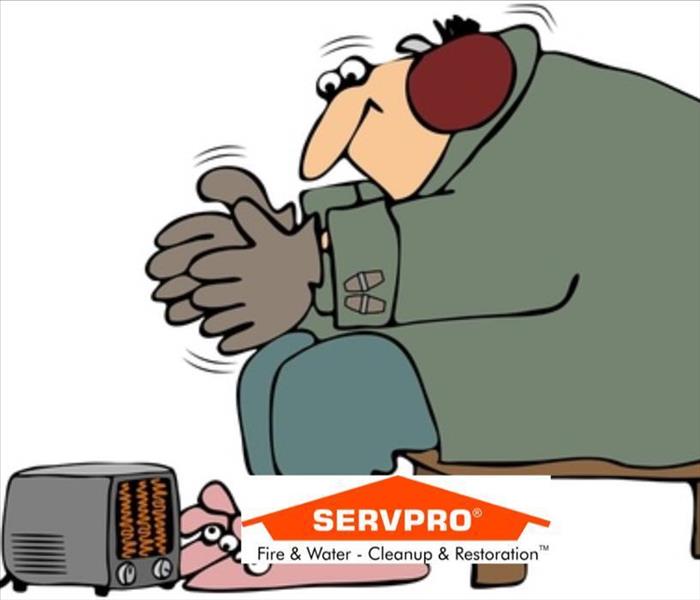 Call SERVPRO of West Fort Bend County at 281-342-5326!
Call SERVPRO of West Fort Bend County at 281-342-5326!
Portable Space Heaters
- Keep combustible objects at least three feet away from portable heating devices.
- Buy only heaters evaluated by a nationally recognized laboratory, such as Underwriters Laboratories (UL).
- Check to make the portable heater has a thermostat control mechanism and will switch off automatically if the heater falls over.
- Only use crystal clear K-1 kerosene in kerosene heaters. Never overfill it. Use the heater in a well-ventilated room.
Fireplaces and Woodstoves
- Inspect and clean woodstove pipes and chimneys annually and check monthly for damage or obstructions.
- Use a fireplace screen heavy enough to stop rolling logs and big enough to cover the entire opening of the fireplace to catch flying sparks.
- Make sure the fire is completely out before leaving the house or going to bed.
Children
- Take the mystery out of fire play by teaching children that fire is a tool, not a toy.
- Store matches and lighters out of children's reach and sight, preferably in a locked cabinet.
- Never leave children unattended near operating stoves or burning candles, even for a short time.
Attics and Crawl Spaces
7/9/2021 (Permalink)
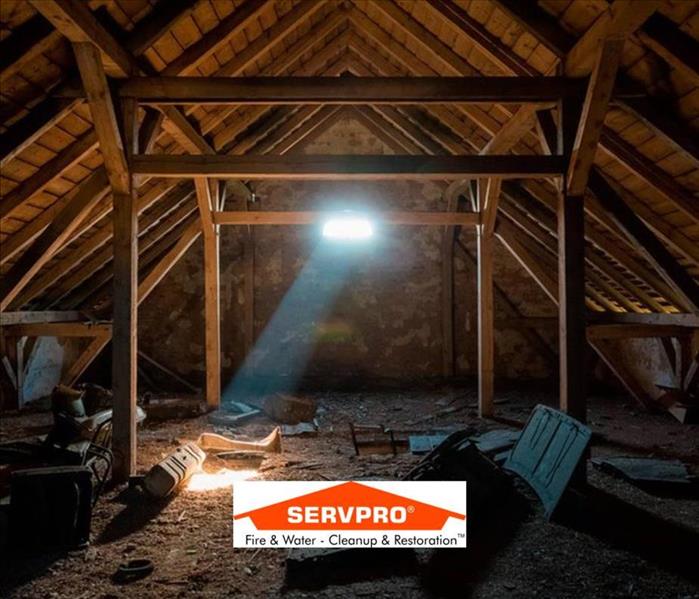 Call today SERVPRO of West Fort Bend County at 281-342-5326
Call today SERVPRO of West Fort Bend County at 281-342-5326
Inaccessible attics and crawl spaces are easy to forget about, but 13% of electrical fires start in these neglected spaces. Electrical failure or malfunction account for about 88% of these fires.
If you live in an older home, suspect dubious DIY electrical work, or want reassurance that everything is in order, hire a professional, licensed electrician to check it out and address issues. While electrical problems can be expensive to fix, the cost of neglecting it can be devastating.
Laundry rooms
Laundry rooms are where 4% of residential fires begin, with dryers being the culprit of 92% of laundry room fires.
Fortunately, preventing laundry fires is simple for the most part:
- Don’t overload your washer or dryer or pack items down. Instead, leave room for laundry to tumble. Follow your machine manufacturer’s recommendations for capacity.
- Clean the lint screen and drum between loads to prevent buildup.
- About once a year, clean the dryer exhaust vent and ducts.
- Replace plastic venting material with flexible metal venting material.
- Ensure that your appliances are plugged into outlets with the proper voltage
Inventory is Important!
7/9/2021 (Permalink)
Your insurance company will want an inventory of everything that was lost or damaged during the fire. Your agent can provide you with an inventory sheet. Review any inventory you made prior to the fire and make additions to it. If you need to reconstruct a list of your belongings from memory, review photographs and video to refresh your memory, and ask friends or relatives who have been in your home to help you compile your list. Review old credit card statements and bank records to determine what you paid for your belongings.
Take care of yourself and family
A home fire is a traumatic experience and you could suffer the effects of the trauma for months and even years afterwards. Allow yourself time to heal, and seek counseling if you have trouble sleeping, concentrating or relating to others weeks after the fire. Return to your normal routines as soon as possible, and help your children to maintain their returns. Talk with children about their feelings and help them to process what has happened.
Winter Fire Hazards
1/11/2021 (Permalink)
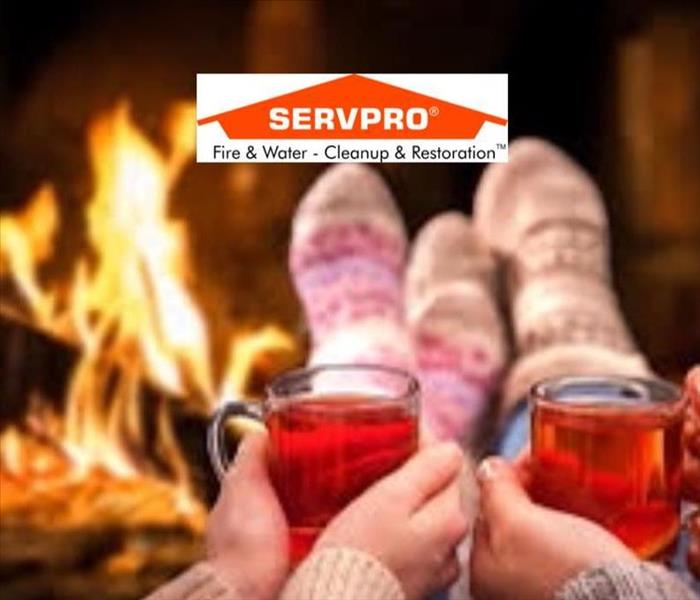 Call SERVPRO of West Fort Bend County today at 281-342-5326.
Call SERVPRO of West Fort Bend County today at 281-342-5326.
With the changing of the seasons comes cooler weather, and for most of us, it is a welcome change. Who doesn’t love snuggling up before a warm fire at this time of year? We’ve pulled out the sweaters and fluffy blankets to stay toasty, and most of us will employ a space heater or two before spring comes around again.
In your place of business, you will be taking those extra steps to make sure your staff is comfortable during the colder months, as well. Let’s make sure they stay fire safe! Here are some winter fire hazards to be aware of:
- Most businesses won’t be using a fireplace to warm their interiors, but those who work out of doors may build fires on the job site to keep hands and toes functional. Make sure your crew is careful to use metal receptacles for those bonfires and that they place them far away from flammable materials such as wood and linens. If a wind comes up, things could get dangerous fast.
- In your offices, the use of space heaters will be helpful. Inspect every unit used to make sure that cords and plugs are in good working condition, and enforce a policy that ensures they are never left running when the room is unoccupied or when the workday is over. Designate someone to oversee this; they should be the person who is normally last out the door. As the owner, it may very well be you.
- Employ a landscape company to remove leaves and dead vegetation from your property. In the event of a fire in your building, space that is cleared from the foundation and exterior walls will help firefighters to gain access as well as prevent a fire from spreading further.
- When repairing or renovating your offices or outbuildings, use fire-resistant materials whenever possible. Flooring, furniture, and paint can all be produced or treated after purchase to make them more fire safe.
The team here at SERVPRO of West Fort Bend County is always available to help you keep your business fire safe. In the event of damages sustained from fire or water, we have the experience and know how to complete a cleanup project quickly and efficiently, getting you back to work as soon as possible.
Should You Get A Roof Replacement?
10/7/2020 (Permalink)
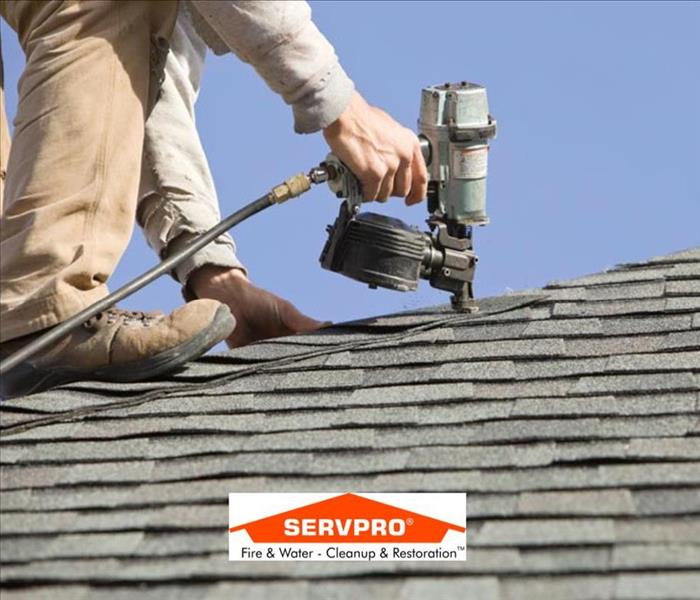 Call SERVPRO of West Fort Bend County today at 281-342-5326!
Call SERVPRO of West Fort Bend County today at 281-342-5326!
When it comes to knowing how often you should replace your roof, there really isn’t any hard and fast rule. You have to keep an eye on its condition to be able to tell if you need to start thinking about it. If your roof is showing signs of damage, that could lead to major water or storm damage to the rest of your home. Our team wanted to share a few potential issues your roof may develop; any one of these may mean it’s time to replace your roof.
Age
An asphalt shingle roof should last between 20 and 30 years, so if you have a 40-year-old roof, just keep in mind that you will probably need to replace it entirely in the next 1-5 years.
Shingles
Shingles can curl in two ways: by “cupping,” which happens when the edges of the shingles turn upward; and “clawing,” which is when the edges stay flat and the middle starts to come up. Both are signs of weathering and indicate that potential leaks may possibly be developing, depending on the extent. Every homeowner finds themselves replacing a missing shingle, but it can be just about impossible to get a new shingle to match the color of an old one. Granule colors have changed pretty significantly over the years, and shingle colors often change with years of weathering. If your roof is starting to look like a patchwork quilt, you may want to consider replacing it soon.
Damage
Cracked shingles are typically caused by wind damage, and if the damage is extensive and not isolated to just one area, you should start thinking about replacing your roof within the next few years.
Algae Or Moss
This is not a big deal when it shows up on your roof, but it doesn’t give your home or business a great look. You don’t want to take matters into your own hands by power washing or scraping it away since that will often chip off all the protective granules and essentially render your shingles useless. You can use a wash that's one part bleach and one part water to remove algae or moss, and if you do decide to replace your roof, consider tiles that are algae-resistant.
Light
This issue is pretty obvious: if light can get in through your roof, so can rain. If you see any water stains during the next rainfalls, and if they spread or expand, you have an active leak, and it is time to contact SERVPRO of West Fort Bend County immediately to help remediate the water damage and potential mold growth.
Sagging
A sagging roof is typically an indication of a structural issue and demands immediate attention. There could be a problem with the decking in the attic or with the supports in the foundation, which is even worse. You're not necessarily in imminent danger, but this is the kind of thing that's a lot easier to take care of when it's small and localized, so call your roofing professionals right away for this roofing issue.
When it comes to replacing your roof, there is no hard and fast rule. If you are experiencing water damage, it is probably time. Remember that SERVPRO of West Fort Bend County is here to help if you are dealing with water damage, fire damage, or a mold infestation. We are committed to getting your business Certified: SERVPRO Cleaned!
Office Fire Safety Precautions!
10/7/2020 (Permalink)
In the event that a fire ever occurs in your office, it’s important to have a few fire safety precautions in place to keep your employees and commercial building prepared for dealing with one. While having a fire extinguisher and smoke detectors goes without saying, do your employees know what to do if the alarm sounds or they have to use the extinguisher?
Here are a few fire safety precautions that you should ensure are in place:
- Make sure your employees know how to use a fire extinguisher. Every 6 months or so, hold a training session where your employees learn how to use a fire extinguisher if they don’t already know how to use one. Something as simple as this could be the difference between an accidental office fire from a microwave or a lighter being extinguished or burning up everything in sight.
- Regularly change your smoke detectors’ batteries and ensure one is installed in every room. As a general rule of thumb, test your smoke detectors once a month and replace their batteries twice a year. By ensuring that your smoke detectors do their job and have the battery juice to sound, you can prevent office fires whenever smoke occurs first.
- Share your office’s evacuation plan. Depending on the size of your office, you need to have one or multiple evacuation plans to adhere to the building’s fire code. Make sure to take into account any legal requirements for fire evacuation plans before you post them around the building and share them.
- Do a few fire drills. Sharing your office’s evacuation plan isn’t enough. Hold a couple fire drills and run your employees through the proper evacuation routes so they know where to go if the building catches on fire. Rehearsing an evacuation plan makes it that much easier to take action in the event that a fire actually occurs.
With all of these fire safety precautions in place, we hope that you’ll never have to manage the aftermath of an office fire. However, If you ever end up dealing with fire damage, water damage, mold, or other natural disaster damage, give SERVPRO of West Fort Bend County a call at (281) 342-5326. Our team of professionals are trained and equipped to help you manage restoration and cleaning.
Fire? We've Got You!
7/6/2020 (Permalink)
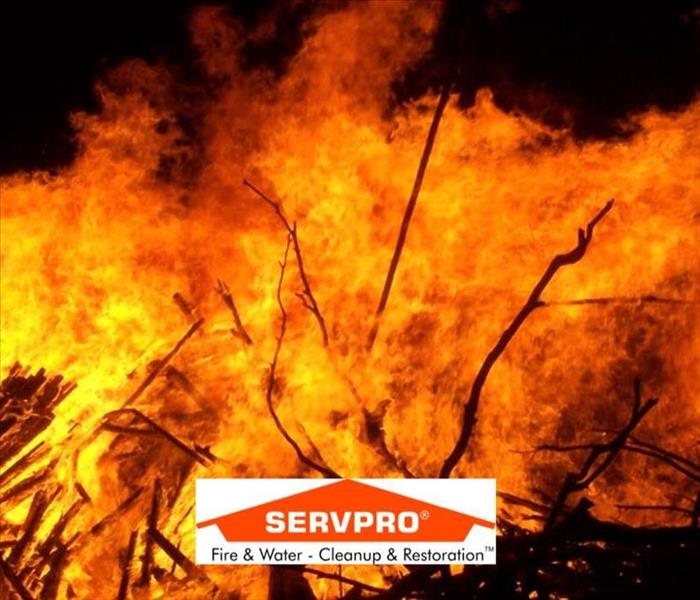 Call SERVPRO of West Fort Bend County today @ 281-342-5326!
Call SERVPRO of West Fort Bend County today @ 281-342-5326!
Fires are absolutely terrifying, even the idea of a home fire sends a shiver down my spine. They are life altering events, that will most likely be talked about for a lifetime. We know they’re scary, which is why we are here to help you every step of the way. Our teams are caring and compassionate and know just how to handle the situation at hand. We focus on restoring, not replacing, so any and all of your belongings that can be restored will be, and you can rest assured that they will be taken care of as though they are our own. We have special equipment, tools, and cleaning supplies to make sure that your life gets turned right side up, and you’re back on your way.
Give us a call today at 281-342-5326!
Carbon Monoxide Alarms
7/6/2020 (Permalink)
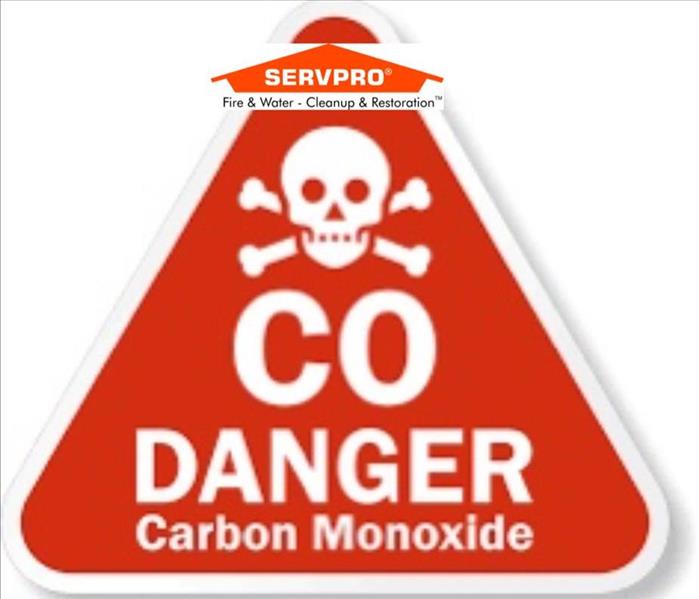 Call SERVPRO of West Fort Bend County today at 281-342-5326!
Call SERVPRO of West Fort Bend County today at 281-342-5326!
Carbon Monoxide Alarms
Install carbon monoxide alarms to alert your family to this invisible, odorless, colorless gas before it’s too late. Carbon monoxide is created when fuels (such as gasoline, wood, coal, natural gas, propane, oil, and methane) burn incompletely. Even a small amount of carbon monoxide can poison or kill a person if it is breathed in over a long period of time – such as overnight while sleeping.
- Install carbon monoxide alarms in central locations on every level of your home and outside sleeping areas.
- If the carbon monoxide alarm sounds, move quickly to a fresh air location outdoors or by an open window or door.
- Never use a generator, grill, camp stove or other gasoline, propane, natural gas or charcoal-burning devices inside a home, garage, basement, crawlspace or any partially enclosed area.
Home Fire Sprinkler Systems
7/6/2020 (Permalink)
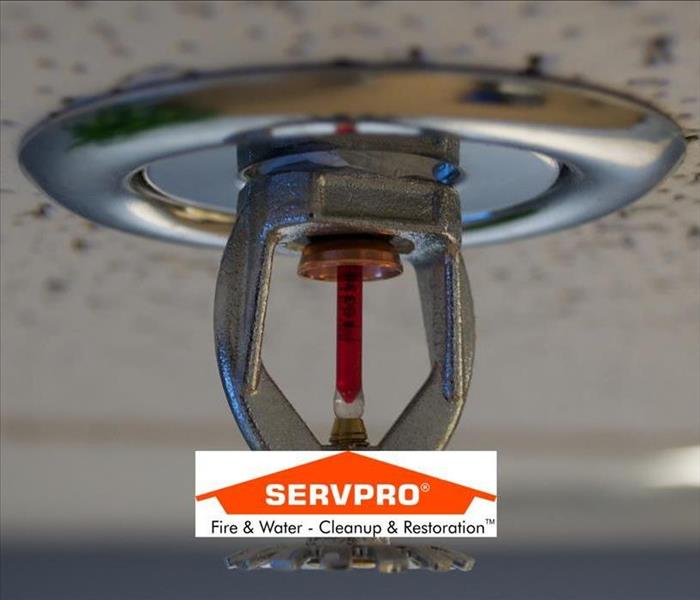 Call SERVPRO of West Fort Bend County today at 281-342-53266
Call SERVPRO of West Fort Bend County today at 281-342-53266
Home Fire Sprinkler Systems
Consider installing an automatic fire sprinkler system in your home. Smoke alarms are designed to detect, not control, a fire. Home fire sprinklers complement the alarms' work, providing a way to fight flames immediately.
- Before the fire department can reach your home, sprinklers can prevent a fire from spreading and even extinguish a fire.
- A sprinkler system can decrease the chance that deadly smoke and gases will reach your family.
- In addition, sprinkler systems can put out fire when you are away from home, and if they are connected to an alarm system, may notify the fire department in your absence.
To ensure sprinkler system reliability, be sure to use a qualified installer who adheres to National Fire Protection Association (NFPA) codes and standards and local fire safety regulations
Remember to stay LOW!
1/9/2020 (Permalink)
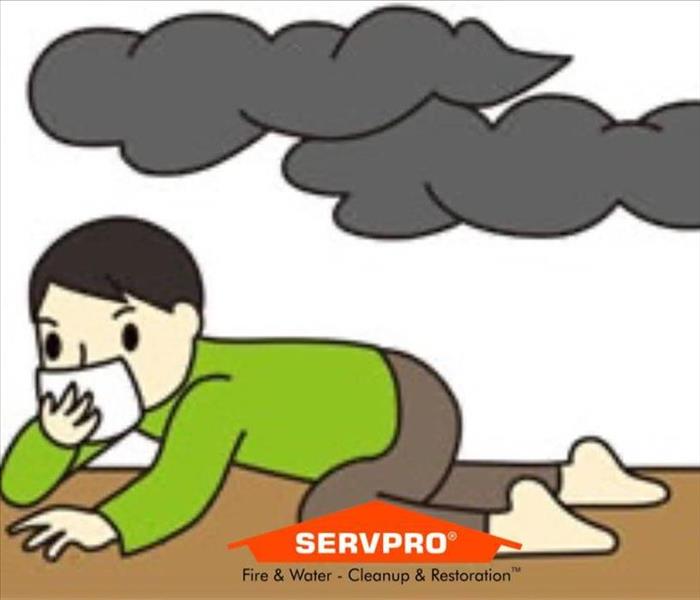 Call SERVPRO of West Fort Bed County at 281-342-5326 today!
Call SERVPRO of West Fort Bed County at 281-342-5326 today!
Stay Low
If you can see smoke in the house, stay low to the ground as you make your way to the exit. In a fire, smoke and poisonous air hurt more people than the actual flames do. You'll breathe less smoke if you stay close to the ground.
Smoke naturally rises, so if there is smoke while you're using your escape route, staying low means you can crawl under most of it. You can drop to the floor and crawl on your hands and knees below the smoke.
Know How to Get Out of the House
Getting out through a door that leads outside should be your first choice as an escape route. But also ask your parents about windows and if they would be possible ways to get out. Even windows on a higher floor could be safe escape routes if you had help, like from a firefighter or another adult.
Ask your parents to teach you how to unlock the windows, open them, and remove the screen, if needed. Make sure you only do this in an emergency! Lots of kids are injured because they fall out of windows.
Sometimes, families even have collapsible rescue ladders that can be used to escape from upper floors of a house. If you have one, ask your mom or dad to show you how it works.
Besides planning your escape routes, you'll also want to know where family members will meet outside. This is helpful because then everyone shows up in one place and you'll know that everyone is safe. You might choose the front porch of a neighbor's house or some other nearby spot.
We Are Here To Help!
10/7/2019 (Permalink)
Fires are devastating and can mean so much heartache and headache for your home. We know that, and that’s why we make it our mission to treat every fire with the care and compassion needed to make sure that your fire is handled in a quick, professional, and caring manner. We treat every fire the exact same, whether it’s a huge office building, or a small home. We want our customers to make sure they feel heard and understood with their concerns. We work hard to bring your home back to preloss conditions and will clean everything top to bottom in the affected area. We will even wash your textiles for you if they’ve got a gross soot smell to them.
If you’ve been affected by a fire, give us a call today at 281-342-5326!
Heightened Risk Of Fire Damage For Halloween
10/7/2019 (Permalink)
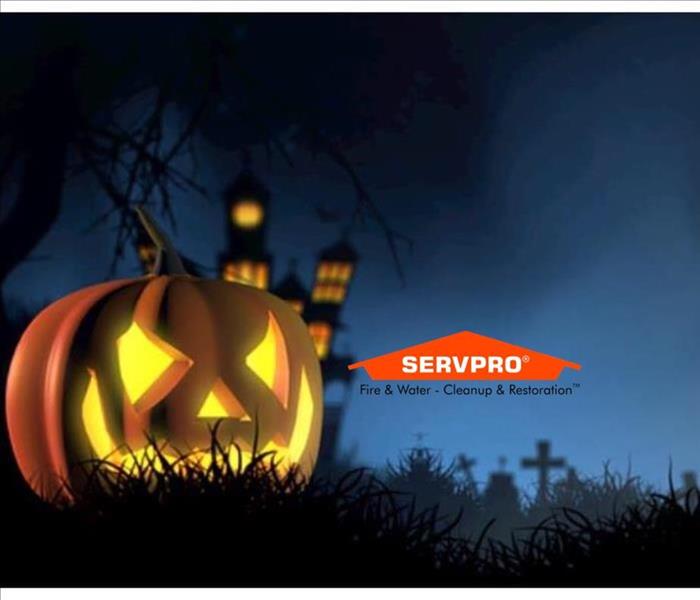 If you found yourself in the midst of a fire because of a holiday decoration mishap, give us a call today at 281-342-5326
If you found yourself in the midst of a fire because of a holiday decoration mishap, give us a call today at 281-342-5326
With Halloween coming up, it’s officially spooky season! It’s definitely my favorite time of the year. I love all the decorations, pumpkins, and the cooler weather coming in is always a plus. But, with that comes a heightened risk of fire damage. Did you know that on average, Halloween decorations cause about $13 million dollars’ worth of damage each year? Along with that, decorations caused about 860 home structure fires per year between 2009-2013! That’s just the beginning – those numbers climb through the rest of the year with fire damages escalating because of the holiday season.
It’s important to make sure that we are fire aware when it comes to decorations and the holidays. Make sure that all decorations are away from heat sources, including flowy costumes. Make sure you blow out your candle when you leave the room, and if you want to have the smells of a candle, but not the flame invest in a wax warmer – though make sure you follow good safety habits when it comes to electrical heating elements. It may not have fire, but it still can be hot! If you like the look of candles, but don’t mind not having a scent – get battery operated candles! They come in various sizes, shapes, and colors and often times are made out of wax. They are fireproof, pet proof, and kid proof!
Fire Plan Anyone?
7/8/2019 (Permalink)
House fires are unpredictable. As much as we try to prevent them, sometimes the unthinkable happens and a little spark from faulty wiring you didn’t know about can leave your home engulfed in flames. When this happens, do your and your family have a plan for getting out of your home and to a safe meeting point? A fire escape plan is an invaluable tool to make sure you and your family knows just what to do incase of a fire.
- Take a weekend and draw up a floor plan of your home for a visual to plan out a fire escape route. Walk through your home with your floor plan and note all the possible exit routes.
- Keep leashes and carriers by the door, and make sure your pet always wears her collar and tags if she escapes during the chaos. Note where your pet goes when scared to tell a firefighter if you don’t have the opportunity to get them out. Train your pet to come when they’re called.
- Choose a meeting place away from your home like a neighbor’s mailbox, sign post, or light post and mark the spot on your map.
- Do a tour with your entire family to make sure that they understand the plan.
In case the inevitable has happened, give SERVPRO of West Fort Bend County a call at 281-342-5326
Put Out A Grease Fire FAST!
7/8/2019 (Permalink)
Cooking is not usually considered a dangerous hobby, and many people find it relaxing. Keep your cooking from going south by making your kitchen as safe as you can. Oil is a big ingredient for many dishes, but unfortunately, it can be easy to ignite, and grease fires are not easily put out with water. If you have a grease fire in your kitchen, you need to act quickly to keep the fire from spreading. Follow these steps to put out a grease fire in your kitchen;
- Turn the Heat Off: This step may seem obvious, but in the heat of the moment, you may be panicking and forget to do so. Leave the pot where it is or you risk burning yourself and spilling oil which could spread the fire.
- Put a Metal Lid on the Pot: Fire uses oxygen to burn, so putting a metal lid on the pot will cut off that supply of oxygen. DO NOT use a glass lid; the heat could cause it to shatter. Once the fire burns through the small amount of oxygen left in the pot, it will put itself out. Keep in mind that this will only work if the fire is contained to the pot and has not spread to any other part of the kitchen.
- Use Baking Soda or Salt: This is another trick that will work if the fire is relatively small and contained. Baking soda releases carbon dioxide which smothers the fire, but if the flames are already too large, this may not work. You will need a lot of baking soda for this. Another trick you could try is using salt. Salt is able to absorb a lot of heat, so it is able to remove so much heat that the grease simply can’t support its own combustion any more.
- Use a Fire Extinguisher: Every household should have a fire extinguisher in an easily accessible part of their kitchen. Once you have gotten your fire extinguisher and you have had it properly inspected, you should know how to properly use it, or you could make the flames worse. Do not stand directly in front of the fire when you spray the extinguisher, or the pressure from it can actually spray the grease further and spread the fire. Stand back at a safe distance and spray the fire. This may take a little longer than you would think, so continue using the extinguisher until you are sure the fire is out. Using a fire extinguisher will contaminate your kitchen, so make sure you give it a thorough cleaning before cooking in it again.
- Call 911: If the fire does get out of control, call 911. It is better to do this sooner than later. Get yourself and any family members out of the house until the fire department arrives.
If you need restoration after fire damage, call SERVPRO® of West Fort Bend County today at 281-342-5326.
What To Do "Electrical Fires"
7/5/2019 (Permalink)
Fires in the home can come in many forms. One of the most dangerous fires is an electrical fire. Electrical fires are especially dangerous because not only is a fire ignited, the electricity has the potential to shock an unsuspecting victim.
Causes of Electrical Fires
Electrical fires often catch homeowners off guard when they are doing something they do everyday, like using a household appliance or plugging something into a socket or power strip. Below is a list of the common causes for electrical fires:
- Faulty outlets and appliances
- Light fixtures, lamps, and light bulbs
- Extension cords
- Space heaters
- Faulty wiring
December and January are the months with the most electrical fires due to an increased amount of heating appliances and lights. However, electrical fires can spark without the overhaul of Christmas lights. Overburdening your electrical outlets with any appliances can quickly spark an electrical fire.
How to Prevent an Electrical Fire
Here are some helpful tips to keep from falling victim to an electrical fire:
- Discard all cords and plugs that are worn or frayed
- Never break off the 3rd prong on a plug to plug it in to a 2-prong socket.
- Keep electrical cords away from water and heat sources.
- Avoid running electrical cords under rugs.
- When unplugging an item, hold the plug securely and remove the plug from the outlet.
- Only use extension cords temporarily
Properly Putting Out an Electrical Fire
Because electricity is involved, you cannot put out an electrical fire the same way you would a typical fire.
- Call 911 and GET OUT
- Call your local fire department or dial 911.
- Safely exit the building.
- Keep a safe distance from the building until fire fighters arrive.
- Disconnect the Electricity
- If an appliance is on fire, simply unplug the appliance by grabbing the plug and disconnecting from the wall.
- If the fire is in the wall or in an appliance you can’t unplug, safely get to the switch or electrical panel to shut off the electricity.
If the power is ON:
- Smother a small fire with baking soda.
- Use only a class C or ABC fire extinguisher. Remember to use the fire extinguisher properly.
- NEVER use water on an electrical fire that is still energized.
If the power is OFF:
- Use a fire extinguisher. If the power is off, it doesn’t matter which kind of fire extinguisher.
- Use a fire blanket or other thick blanket to smother the fire.
- Douse the fire with water. This is only safe and effective if the power source is OFF.
Tips On How To Prevent Winter Home Fires
1/2/2019 (Permalink)
The winter season is here and with it comes shorter days and lower temperatures. No matter where you live, winter brings a change in the weather. In an effort to keep our homes and workplaces cozy, many people use alternative heat sources like fire places, portable space heaters, and wood burning stoves. Did you know, heating equipment is a leading cause of home fire deaths? According to the National Fire Protection Association, heating equipment fires cause estimated $1 billion in direct property damage annually. Keep the following safety tips in mind to help reduce your risk of a heating-related fire.
- Keep anything flammable at least three feet away from heating equipment, like the furnace, fireplace, wood stove, or a portable space heater. Have a three foot "kid-free zone" around open fires and space heaters.
- Make sure the fireplace has a sturdy screen to stop sparks from flying into the room. Ashes should be cool before putting them in a metal container. Keep the container a safe distance away from your home.
- Remember to turn portable heaters off when leaving the room or going to bed.
- Always use the right kind of fuel, specified by the manufacturer, for fuel burning space heaters.
50% of all residential heating-related fires are reported during the months of December, January and February.
- Have heating equipment and chimneys cleaned and inspected every year by a qualified professional.
- Have a qualified professional install stationary space heating equipment, water heaters or central heating equipment according to the local codes and manufacturers instructions.
- Test smoke alarms monthly.
If your property suffers from fire damage, contact SERVPRO Of West Fort Bend County to help make it "Like it never even happened."
How To Address Fire and Water Damage
10/8/2018 (Permalink)
The fire at your house in Houston, TX is blazing out of control. You watch from the street as the fire hose saturates your home with 1200 gallons of water per minute. You breathe a sigh of relief as the fire is extinguished. Now you face a new challenge, a combination of fire damage and water damage. To combat this disastrous duo, take the following steps to return your home to preloss condition.
Initial Steps.
It is overwhelming when you first see the destruction in your house. You recognize that you cannot clean up the mess yourself. Who do you call?
• Contact the insurance agency that holds your homeowner’s policy. Inform the agent of the damage and discuss coverage and next steps.
• Call an emergency fire and water restoration company. The specialists typically arrive at your home within hours to inspect and assess the damage, day or night.
• Before restoration efforts begin, the specialists may board up windows and/or place a tarp on the roof to secure your property and prevent further damage.
Water Damage.
Firefighters use a significant amount of water to snuff the inferno, leaving your home drenched. What steps do water restoration specialists take to properly dry your home?
• Wet/dry vacuums and pumps extricate flooding and excess water from the house.
• Industrial strength dehumidifiers and air movers remove moisture from walls and floors.
Fire Damage.
The fire is gone, but the soot and smoke remains. How do fire restoration specialists clean and deodorize your house?
• Specialized equipment is used to remove smoke and soot from walls, ceilings and floors.
• Fogging equipment and air scrubbers remove smoke odors from the source.
It is heartbreaking to see your home in Puyallup, WA, engulfed in flames. The aftermath of water and fire damage is equally hard to face. Work with your insurance agent and a fire and water restoration specialist to return your home to preloss condition and resume your life.
For more information, please visit us at www.SERVPROwestfortbendcounty.com
Protein Fires in Houston Texas: What Are They and How Are They Treated?
10/8/2018 (Permalink)
Protein fires create an especially unique restoration challenge. Fire damage caused by burnt food can also create odor issues which are difficult to mitigate. Here are some important facts regarding this type of fire.
- Protein fires generally leave little visible residue, often confusing the untrained observer
- They create a significantly more repugnant smell than most other fires
- The nature of the burn causes the odor to permeate structure and furniture even more completely than other fires
- Require extremely thorough cleaning to remove the odor
- Sometimes require a sealing agent or even repainting to completely eradicate the odor
- May require multiple attempts and methods to achieve customer satisfaction
It is also important to recognize that perception of odor is highly individual. There are no tools available to “measure” smell, and as a result, a homeowner may perceive odors that technicians or even neighbors cannot. Often times, because of the strong link between smell and memory, a homeowner may experience “phantom odors” where the memory of the event causes reproduction of the odor even after thorough cleaning.
Fire Damage In Your Home Or Business? Call the professionals at SERVPRO of West Fort Bend County at (281) 342-5326.
Fort Bend County Smoke and Soot Cleanup
7/2/2018 (Permalink)
Smoke and soot is very invasive and can penetrate various cavities within your home, causing hidden damage and odor. Our smoke damage expertise and experience allows us to inspect and accurately assess the extent of the damage to develop a comprehensive plan of action.
Smoke and soot facts:
- Hot smoke migrates to cooler areas and upper levels of a structure.
- Smoke flows around plumbing systems, seeping through the holes used by pipes to go from floor to floor.
- The type of smoke may greatly affect the restoration process.
Different Types of Smoke
There are two different types of smoke–wet and dry. As a result, there are different types of soot residue after a fire. Before restoration begins, SERVPRO of West Fort Bend County will test the soot to determine which type of smoke damage occurred. The cleaning procedures will then be based on the information identified during pretesting. Here is some additional information:
Wet Smoke – Plastic and Rubber
- Low heat, smoldering, pungent odor, sticky, smeary. Smoke webs are more difficult to clean.
Dry Smoke – Paper and Wood
- Fast burning, high temperatures, heat rises therefore smoke rises.
Protein Fire Residue – Produced by evaporation of material rather than from a fire
- Virtually invisible, discolors paints and varnishes, extreme pungent odor.
Our Fire Damage Restoration Services
Since each smoke and fire damage situation is a little different, each one requires a unique solution tailored for the specific conditions. We have the equipment, expertise, and experience to restore your fire and smoke damage. We will also treat your family with empathy and respect and your property with care.
Have Questions about Fire, Smoke, or Soot Damage?
Call Us Today – (281) 342-5326

 24/7 Emergency Service
24/7 Emergency Service
